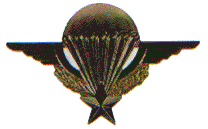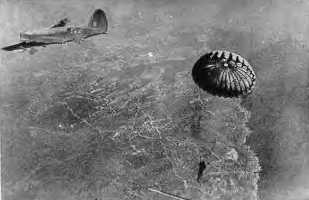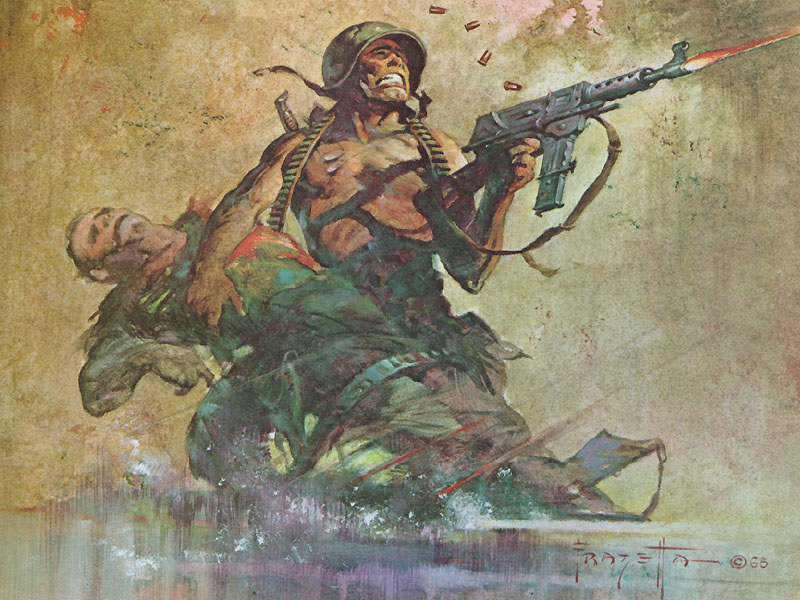 TWO AIRBORNE RAIDS IN NORTH VIETNAM
TWO AIRBORNE RAIDS IN NORTH VIETNAM



During the eight years of war waged by the French Army in Vietnam against the Communist forces of the Vietminh, the two military actions which earned the greatest material and moral success with the least losses and in the shortest time were the Airborne raids on 9 November 1952 at Phu-Dean, and on 17 July 1953 at Lang Son.
Due to the accuracy of intelligence information, the surprise, and the gallantry of the engaged units, these operations in the enemy's rear areas permitted the capture or destruction of important armament and ammunition dumps supporting all the Vietminh activity in North Vietnam.
It is for that reason that the study of these two French Airborne operations presents both historical and didactic interest. In an alliance the knowledge of an ally's experiences; "failures and successes" is the basis of increase in efficiency. After a brief outline of the general situation in Vietnam in October 1952, the planning and execution of the raids will be analyzed to include lessons learned during those operations.
General Situation
When the surprise Vietminh attack began on 19 October 1946 in Hanoi, the French Army had only about 30,000 men in Indochina (area of about 300, 000 square miles, population, 29 million inhabitants), Initially, from 1946 to 1950, warfare was of the "guerrilla" type. Then, slowly, due to the Communist organization and the Chinese help, an open struggle took place from the end of 1950 to 1954.
When the Vietminh High Command launched the invasion of the Thai-country in the autumn of 1952, a balance of power had been reached. (Figure 1.) The objectives of the operation were conquest of a departure line against Laos, liaison with Siam, and capture of the precious opium crop. At this time the Vietminh Army included, in addition to 300,000 local auxiliaries and 120,000 provincial "guerrilleros" a Regular Army with six infantry divisions and one artillery division of about 100, 000 well-equipped and well-trained Soldiers.
On 23 October 1952 Red divisions crossed the Black River, moving toward the southwest. Supply for these troops came from the area of Tuyen Quang, via Yen Bay. The French High Command, instead of dissipating their efforts in a frontal defense, decided to hit the line of communications and enemy dumps in the vital zone of Phu-Dean, between Tuyen Quang and Yen Bay. The attack of Yen Bay, advanced base of the Vietminh offensive action against the Thai-country, would have been the best maneuver, of course. However the available means in ground and air partners in future alliances must be prepared to work and plan together now if they are to attain the ultimate in cooperation. This must include coordination of organization, technical development, and tactics its were not sufficient to conduct such started from Vietri.
By early November operation. There remained only the a strong task force of infantry and armor possibility of undertaking an action had reached an area ahout 20 miles from SOUTH CHINA SEA against Phu-Dean, which was code named the important crossroads of Phu-Dean, Lorraine. where roads and waterways came together Undertaken in October, Lorraine essential to permit the supply of the Vietminh officially was an expanded ground raid which fensive.
Phu-Dean Operation morning of 9 November to drop the force
It was decided to launch an Airborne first to seize the crossing of the road over operation of regimental combat team size the tiver and the crossroads, and then to on each side of the Song-Chay River to destroy the enemy's dumps. The infantry assured the destruction of dumps and in-armor task force, beginning its move dur-stallations of the enemy. A motorized eol- ing the preceding night, was to link up column was to effect a linkup with the air-with the Paratroopers during the day, Airborne force. Code name Mars was given to the Airborne operation. (Figure 2.) The concept of operation was on the The entire area would be mopped up for a few days before withdrawing to Vietri. I was known that the enemy had fairly strong force; in the region of Phu- Dean The Airborne task force included the battalions (1st, and 2nd Foreign Legion Paratrooper Battalions, and the 3rd Colonial Paratrooper Battalion), two platoon each of three 75mm recoilless rifles, on platoon of engineers with crossing equipment, and one destruction platoon. Available for the operation were 53 x C-47's (Dakotas) which were to fly two sorties each and would use Hanoi as departure airfield: The plan provided for the simultaneous dropping of two battalions at 0930, on with the headquarters of the force on a drop zone north of the Song-Chay, the other on a drop zone south of the river. Thedrop was to be conducted after neu-tralization of the bordering villages by fighter planes, and under the protection of B-26 bombers circling over the area during the operation.
 www.youtube.com/watch?v=O0gRJ8z8cq4
www.youtube.com/watch?v=O0gRJ8z8cq4
At 1230 another battalion was to be dropped on the northern drop zone. The jump altitude was 600 feet. The drop zones would be marked with smoke grenades launched by a pathfinder plane three minutes before the in-flight of the first serials.
Conduct of the Operation
The operation went off as planned.
2,354 Paratroopers captured the airhead at the cost of one killed and 16 wounded. At 1700 linkup was made with the motorized task force which assumed command of the Airborne force. Important armament, ammunition, and supply dumps were found. The following naterial was recovered:
34 mortars
30 anti-tank rocket launchers
14 machineguns
40 submachineguns
250 rifles
two 57mm recoilless rifles
For the first time a Russian "Molotova" truck was captured. The Paratroopers carried out the mopping up of the area, destroyed armament factories and food dumps, and dispatched long-range patrols in the direction of Yen Bay with very few losses. On 6 November, after a week of operation, they were brought back by trucks to Hanoi.
Unfortunately, this fine success was limited by a last hour reverse. When the ground task force of Lorraine withdrew two days later as planned, the rear guard ambushed by two Vietminh regiments and lost both men and materiel.
This operation highlighted the fact that although the capture of dumps in the en-my's rear areas is relatively easy by an Airborne operation, it is very dangerous to stay there too long, exposed to a concentrated counterattack from enemy reserves. Operation Lorraine, undertaken with weak forces, succeeded only in hindering the Vietminh offensive in the Thai-country, and did not stop it. The capital, Son La, was captured by the enemy before the end of November, and the French command was obliged to regroup its isolated units around the airfield of Na- San. The Paratrooper battalions which had jumped on Phu-Dean were air-transported to Na-San two days after their return to Hanoi. General Gilles, commander of the Airborne forces in North Vietnam, assumed command of the defending forces. Three Vietminh divisions tried in vain to overun Na-San and were forced to withdraw from the Thai-country with heavy losses.
Lang Son Operation
During the spring of 1953 a new Vietminh offensive on Laos failed in a campaign in which the Paratrooper battalions again distinguished themselves. A degree in balance of power was attained. The Vietminh forces, however, were receiving increasing assistance from Communist China. To cut this Iogietical stream, an Airborne operation, called Hirondelle
(Swallow) was planned. The objective of the operation was Lang Son an important supply dump installation in the enemy's rear area. (Figure 3.) The problem was one of capturing the town and the well-guarded dumps, and destroying material and installations. All this had to be accomplished and the Airborne
force returned to friendly territory, before the Vietminh troops could react. The terrain, mountainous and wooded with only a few roads and trails, presented additional difficulties. The enemy had available at Lang Son one local battalion and two provincial companies plus a few light anti-aircraft units
at the Chinese border, a distance of about eight miles. Elements of an infantry division located near Thai Nguyen could be available in approximately 48 hours. Between Lang Son and Tien Yen eight pro-Colonial Paratrooper Battalions, and Provincial companies were in a position to react during the first day and from four to and one platoon of engineers with four to six battalions the second day, It was, there rubber boats. The pick-up or link-up COIN force, imperative that the operation be completed as rapidly as possible. three "commandos," one tank platoon, one company of engineers with three bulldozers. One Paratrooper battalion and announced by battery of 75mm recoilless rifle (General Gilles was to execute an Airborne raid) were held in reserve on the attack the morning of 17 July in order parture airfields in Hanoi.
Concept of Operation
To capture and destroy the dumps near Lang Son and to seize the crossing over the Song-Ky-Cung. This crossing, in the vicinity of Loc-Binh, constituted the es-sential point for the withdrawaL A ground action assisted by units attacking from Tien Yen was to take place from 17 to 21 July to permit the withdrawal of the Paratrooper force by way of Loc-Binh and Dinh-Lap, to Tien Yen.
The Airborne task force included a headquarters, three battalions (6th and 8th Success of the operation depended on complete surprise as to the date and execution of the raid. For that reason all preparatory planning was accomplished with the utmost secrecy by the force Commander assisted only by an officer of The G3 orders were put in written ft on 15 July; the units were alerted at 1 on 16 July and confined to barracks. 1500 on 16 July tbe battalion command briefing was held. Since the Airborne units could take with them only organic light weapons and equipment, air-support was planned carefully. Fighter aircraft were to attack all installations and observation posts detected on aerial photographs which could intervene on the drop zones. This action was to take place 15 minutes before jump time. Air fire support during the jump and for the subsequent reorganization was to, be provided. In addition, provision was made for continuous strafing and bombing cover and for on-call night illumination from aerial bombs.
The raid began 17 July at 0810 when the headquarters and two battalions were dropped from 56 x C-47s near Lang Son. At 1200, near Loc-Binh, the third battalion with the attached engineer platoon jumped from 29 x C-47s. The operation took place as planned. The Vietminh units were surprised completely. The local policemen and the provincial companies fled. Only the guard detachments of the dumps resolutely resisted. Important dumps were discovered and pre-pared for destruction by special teams. A large quantity of material was captured.
At 1600 the dumps were destroyed and all roads leading to the south and west were mined. The two battalions at Lang Son began their withdrawaL Meanwhile, the Loc- Binh battalion had secured the crossing over the Song-Ky-Cung and was protecting the flank against movement from the Chinese border. At 2300, 18 July the first scouts of the Airborne met in the vicinity of Dinh-Lap, the ground column fighting up from Tien Yen. The engineers were able to re-pair the winding road to some degree and trucks took the Paratroopers back in the last daylight hours of 19 July, On the morning of 20 July the Airborne units were embarked in LCT'S to be brought back to Haiphong, and then by trucks again to Hanoi. Of the 2,001 Paratroopers who jumped in the operation, losses had been extremely light: one killed, one missing, three died from exhaustion during the march, and 21 wounded. This remarkable success, considering the small forces engaged, had a profound repercussion in North Vietnam. The Vietminh war effort was hampered notably in the vital area of the Red River Delta. A wave of confidence spread through the friendly population and the Army.
General Lessons
The two briefly described Airborne raids were accomplished in a theater of opera-tions of a particular type. It is, there-fore, difficult to draw from them general lessons valtd for all types of wars. However, some points are worthy of emphasis and could apply to other theaters. First, intelligence ia extremely important and must be centralized at the highest command level in order that it may be adapted to the ever-changing situation. Due to thorough research combined with the patient questioning of thousands of refugees, the intelligence agency in Hanoi had succeeded in drawing up an exact, precise, and detailed picture of the drop zones and their vicinity, and of the location and strength of the enemy units. Intelligence officers have a tremendous responsibility in operations of this type. Second, if the information is correct, it is relatively easy to operate in the enemy's rear areas. It is very difficult for the enemy high command to have a clear appreciation of the situation, particularly if the Airborne raiders do not remain in the same place but move at once. The most difficult problem is that of returning to friendly territory. In some circumstances, and in difficult zones, it is possible to split up the airborne force in small groups in order either to stay in the enemy country, or to return to friendly territory. Third, all objectives are suitable for an
Airborne raid whether they be military, political, or economical. The sabotage of an industrial research plant may be as important for the final victory as the elimination of a "quisling" government. Fourth, it must be kept in mind that the varied possibilities of Airborne raids ean be realized only when the necessary means that is, trained Airborne units and planes in required quality and numbers are available. The French High Command in Vietnam always was aware of the advantage of using Paratroopers. In December 1950 there were 6,000; in 1951 about 11,000; and in 1954 more than a dozen picked battalions, half of them in the Vietnamese Army, were available with Airborne support units of artillery, engineers, signal, and medical corps. The greatest shortage was in aircraft. This is a lesson to be remembered: it is not enough to have many, well-traned Airborne units when the corresponding number in planes
is not assured. First, the Airborne raid involves a cal-culated
risk. However, if carried out with imagination and daring the
outweigh the risks involved.
Conclusion
Benefits far An Airborne raid has many advantages in the event of a localized war, and particularly at the beginning of a conflict, The army that is provided with trained Airborne troops and sufficient troop-carrier and assault planes possesses great flexibility. An Airborne operation or a great number of Airborne raids may well permit the attainment of vital objectives which otherwise would require large ground forces and extensive operations. To attain the ultimate in cooperation the partners in future alliances must be prepared to work and plan together now, A common endeavor of organization, of technical development, and of doctrinal understanding would be of great benefit The French Paratroopers, with many gallant actions behind them, stand ready imbued with the motto: "Who dares, wins!"
"New firepower and mobility capabilities, plus uew and improved means of control, permit wide flexibilityy in selection of the maneuver plan. Tactics should be designed to locate the enemy, determine his configuration, deliver appropriate fires on acquired targets, and exploit the resultant situations with highly mobile forces. On a strategic level, forces must be organized and equipped so that they can be delivered by air or surface transportation to any area of the world for engagement in either atomic or non-atomic situations on any reasonable type of terrain. Suitable air and surface lift must be provided. The time of initial intervention, particularly in limited war, may be just as important as the time required to close a sizable force."
Brigadier General T. F. Bogart
FEEDBACK!
E-mail 1st TSG (A) itsg@hotmail.com